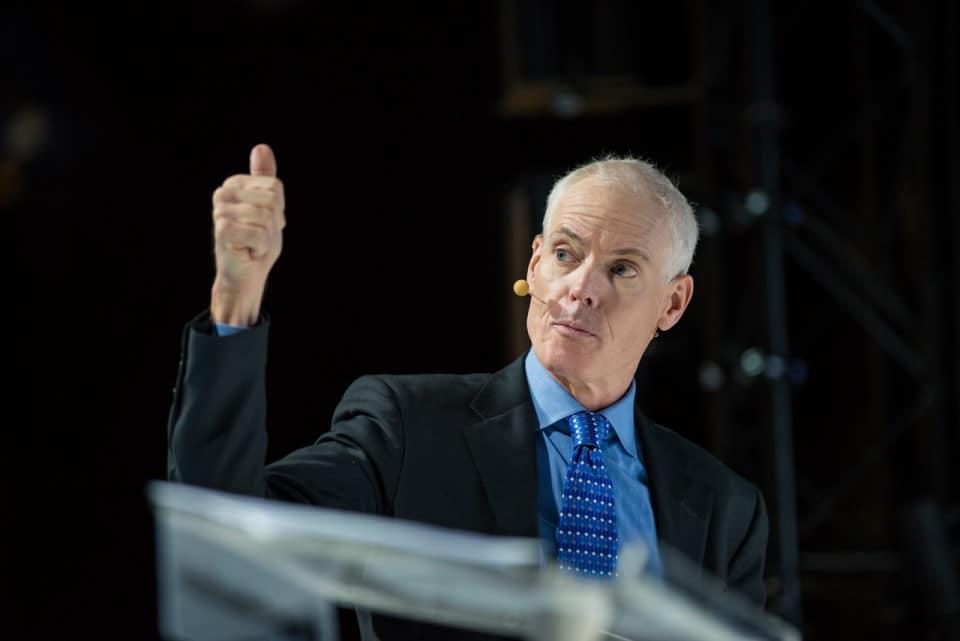2Feb2015
“Good is the enemy of great,” declares Jim Collins. He would know as he is the man who has spent 25 years looking at what makes a company great.
Jim Collins has over 6,000 years of combined corporate history in his corporate history database. He has compiled that research into numerous books that include Good To Great and Great By Choice. Clearly, many attendees of the Nordic Business Forum are acutely familiar with these works as many hands shoot up when he asks who in the room read his books.
Jim organizes his talk around 12 questions that he has distilled from his canon of work. The questions are his way of helping leaders take what he has learned and instill the principles needed for success by asking and wrestling with the questions.
1. Are we willing to strive for Level 5 Leadership, and to embrace the 10X behaviors needed to build a great company or social sector enterprise?
In his book Good To Great Jim discusses the five levels of leadership. Level one is having good individual skills. Level two is having good team skills. Level three is having good management skills. Level four is becoming an effective leader. The fifth level represents the highest level. Someone does not need to be charismatic for great leadership – it is not about personality. Also, they don’t have to be powerful, for power is not great leadership either. “If you have a charismatic cause, you do not have to be a charismatic leader,” he says.
What makes a level five leader? A level five leader is humble. Level five leaders have as much ambition and drive as level four leaders. However, for level four leaders all of that ambition and drive is about them. It’s about what they get, how they look, and what they make. A level five leader channels energy outward. Level four leaders are good at getting people to follow them, but level five leaders are good at getting people to follow a cause. “They lead in a spirit of service and consume themselves in sacrifice.”
2. Do we practice the principle of First Who, with the Right People on the Bus and in the right seats?
When he first conducted his research for Good To Great, he expected level five leaders might come in and set a new direction and motivate people to go in that direction. Instead, he found the opposite. They came in and said, “I’m not going to figure out where to drive this bus until I have figured out who should be on the bus, who should be off the bus, and who should be in the seats.” In other words, first get the right people and then figure out where to go.
3. What are the Brutal Facts, and how can we better live the Stockdale Paradox?
The process of going from good to great is one of disciplined people who engage in disciplined thought and take disciplined action. Jim noticed while doing research that level five leaders have a particular kind of disciplined thought that he calls the Stockdale Paradox. It’s named after James Stockdale, who was a U.S. Navy Vice Admiral and one of the most highly decorated officers in the history of the U.S. Navy. He was the highest ranking military officer in the Hanoi Hilton prisoner of war camp in Vietnam. He was shot down in 1967 and was there until 1974. He was tortured over 20 times.
Jim got to know Vice Admiral Stockdale and wondered how he did not capitulate while in Hanoi Hilton. When asked by Jim, Stockdale answered that he never capitulated to despair because he never wavered in his faith that he would not only get out but turn his time as a prisoner of war into the defining event of his life. He said that the optimists were the ones who did not make it out of Hanoi Hilton. They were the ones who said they would be out by Christmas, and Christmas would come and go. They died of a broken heart. He learned that you can’t confuse the need for unwavering faith that you will prevail with the discipline to confront the most brutal facts.
4. What do we understand so far about our Hedgehog Concept—what we are fanatically passionate about, what we can (and cannot) be the best at, and what drives our economic or resource engine?
There is an essay called “The Hedgehog and the Fox” by Isaiah Berlin who said there are two types of thinkers: hedgehogs and foxes. The foxes love complexity and all the moving parts. They love showing how smart they are by making things so complex that other people can’t understand them. Hedgehogs tend to take the approach of saying, “I know the world is complex, but we can’t function if we don’t simplify it.” Hedgehogs get one big idea and focus on it. They simplify a complex world down to a fundamental, simple idea that is essentially right. “In the world of leadership, the hedgehogs win,” Jim declares.
5. How can we accelerate clicks on the Flywheel by committing to a 20 Mile March?
In 1910, two men led teams to explore Antarctica: Roald Amundsen and Captain Robert Falcon Scott. Amundsen’s team was successful while Scott’s team died. Both had the same conditions, but had different approaches. Scott responded to the conditions. If the conditions were good he would do really big pushes, but he would sit in his tent complaining about the weather when it was really bad. Amundsen had his team march 15 to 20 miles a day. He had his team moderate their pace by discipline and not conditions.
6. Where should we place our big bets, based on the principle “Fire Bullets, then Cannonballs”—blending creativity and discipline to scale innovation?
When looking at entrepreneurs, Jim explains to us that he was puzzled by the concept of innovation and the role it plays. He expected the best leaders to out innovate the others. He discovered that was not necessarily the case. Great leaders do innovate, but they don’t out innovate. “Pioneering innovation is great for society, wonderful for the economy, but statistically lethal for the innovator,” he says. The key thing is not innovation but how they innovate. Great leaders have the ability to scale innovation.
7. Do we show any signs of How the Mighty Fall, and do we have enough Productive Paranoia to stay far above the Death Line?
Some of the greatest companies in the world ended up falling. What’s scary is that they were once great and then fell. If they can fall, anyone can fall. How can a company stay great and not fall? What Jim found is that you need a healthy dose of what he terms “productive paranoia.” According to Jim, productive paranoia means, “channeling your anxiety and your worry into preparation that keeps you alive.” Productive paranoia means worrying about everything that can go wrong and putting preparations in place that allow you to have options to deal with problems.
8. How can we do a better job at Clock Building, not just Time Telling?
The great entrepreneurs are clock builders not time tellers. The really great entrepreneurs don’t want to be the time teller, the one everyone depends on to tell the time and set the direction. Instead, they want to build a clock to tell the time even when they are not around. They want to build a culture of people who can do amazing things, a culture that outshines them.
9. Do we passionately embrace the Genius of the AND—especially the fundamental dynamic of “Preserve the Core AND Stimulate Progress”?
The idea is that the best leaders are the ones that are really good at holding two seemingly opposite things in the mind at the same time. Jim noticed in his research that really great leaders are “and” people and do not succumb to the tyranny of the “or.” There is a sort of yin/yang principle going on in great businesses. On one side you have preserving the core, or staying true to something, and the other side you have stimulating progress. “This is the big picture of why some endure as great and some do not,” Jim says.
10. What is our BHAG – our Big Hairy Audacious Goal – and do we have the SMaC to achieve it?
You have to keep setting big goals in order to succeed. Every time you are about to get to the top of the mountain, every time you are about to summit, you say to yourself, “What’s the next mountain?” You want to keep setting bigger and bigger goals. That’s how you stay away from complacency. Big goals will make you better. “A meaningful life is full of BHAGs,” Jim declares.
11. How can we increase our Return on Luck (ROL), making the most of our good luck and bad?
Throughout his research, Jim noticed that many of the greatest leaders believed they were exceptionally lucky along the way. The more successful people were, the more they attributed luck as a factor to their success. If you are intellectually honest, you have to ask, “How much of this just comes down to luck?” Asking that question is a form of humility and a form of productive paranoia.
Successful leaders got a good return on luck. It doesn’t matter whether you get good or back luck. What matters is what you do with the luck you get. Be attuned to the good luck that you have and never squander it.
12. What should be on our Stop Doing list?
This is a question about real discipline. Most of us have “to do” lists, but most of us don’t have stop doing lists. “True discipline begins not with what we do, but what we have the discipline to not do.” So what’s the first thing on your stop doing list?
Key points:
- Good is the enemy of great. Don’t be satisfied with where your company is at. Instead, strive for more.
- Make sure you have the right people in place. First get the right people and then figure out where to go.
- Have a Big Hairy Audacious Goal (BHAG). You have to keep setting big goals in order to succeed.
Jim Collins is the author of many international bestsellers like Built to Last and Good to Great. All of his books are based on research and they have sold more than 10 million copies worldwide. Many consider Collins as the greatest business author alive.
[sam id=”4″ codes=”true”]



 by:
by: